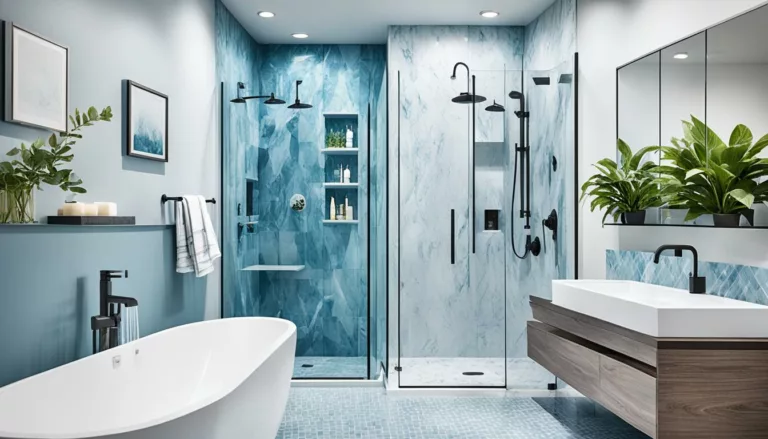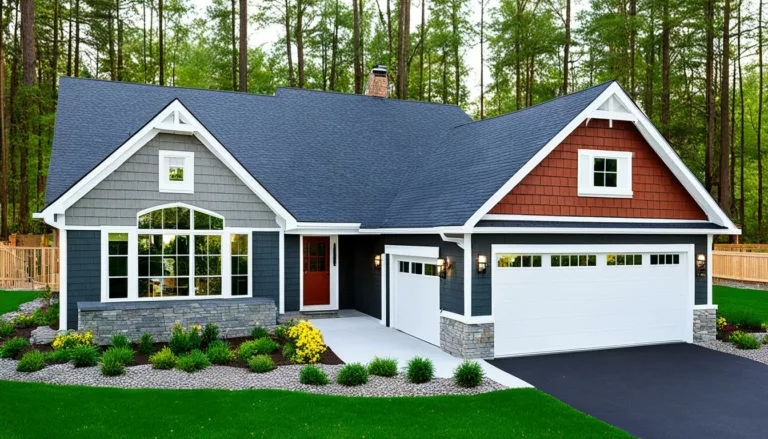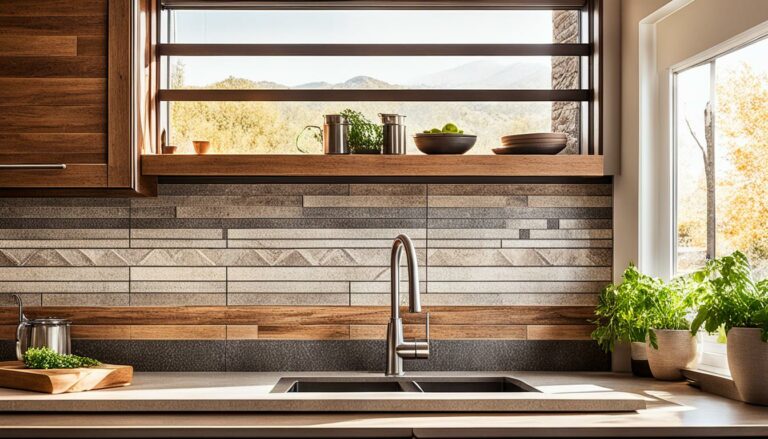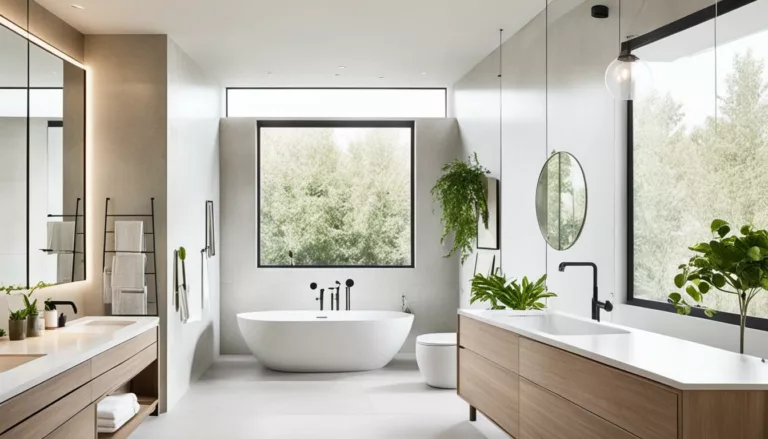Today, we all want to make our homes more eco-friendly. If you’re planning a kitchen remodel, this is a great chance to go green. You can pick materials and designs that are good for the planet and make your kitchen look better.
This article will show you how to make your kitchen greener. You’ll learn about sustainable materials, energy-saving appliances, and ways to use less water. By choosing wisely, you’ll help the planet and enjoy a kitchen that’s both beautiful and functional.
Key Takeaways
- Explore sustainable materials for your kitchen countertops, cabinets, and flooring.
- Invest in energy-efficient appliances and innovative technologies to reduce your energy consumption.
- Implement water-saving fixtures and strategies to conserve this precious resource.
- Incorporate recycled and repurposed components to minimize waste and environmental impact.
- Choose non-toxic finishes and paints to create a healthier indoor environment.
Embracing Sustainability in Your Kitchen Renovation
Remodeling your kitchen should focus on being green. Using sustainable materials cuts down on carbon emissions and makes your home healthier. We’ll look at the perks of non-toxic finishes and recycled components. We’ll also see how a green kitchen makeover benefits your home and the planet.
Why Choose Eco-Friendly Materials?
Materials like bamboo, recycled glass, and natural stone are better than traditional ones. They’re tough, need little upkeep, and are kinder to the earth. Adding them to your kitchen makes a sustainable choice and helps your home last longer.
Benefits of a Green Kitchen Makeover
A green kitchen makeover changes your home and the planet for the better. Here are some key advantages:
- Better air inside your home with non-toxic finishes
- Less energy and water use with efficient appliances and fixtures
- Supporting local businesses by choosing locally sourced products
- Less waste and a greener life cycle with recycled components
“Sustainable design is not just about the materials we use, but the impact we have on the environment and our communities.” – John Doe, Eco-Friendly Living Expert
Going green in your kitchen renovation improves your home and helps the planet. It’s a choice that benefits everyone, now and in the future.
Sustainable Materials for Kitchen Countertops
When thinking about eco-friendly kitchen makeovers, countertops are key. Luckily, there are many sustainable materials that look great and are good for the planet. Options include recycled glass and natural stone, offering beauty and benefits.
Recycled glass countertops are a top pick. They’re made from old glass, cutting down on waste and saving resources. These countertops are tough, easy to clean, and come in many colors and patterns, adding style to your kitchen.
Quartz countertops are also a green choice. They mix natural stone with recycled parts for a surface that’s sustainable and non-toxic. Quartz is strong, long-lasting, and simple to care for, perfect for modern kitchens.
If you prefer a natural look, consider sustainable materials like local sourcing of natural stone. Granite, soapstone, and limestone are beautiful and kinder to the earth than synthetic options.
“Sustainability is no longer a trend, but a necessity. By choosing eco-friendly countertop materials, you can create a kitchen that is both beautiful and environmentally responsible.”
There are many sustainable materials and recycled components for your kitchen countertops. Picking these green options lets you have a lovely and non-toxic kitchen that supports sustainable living.
Energy-Efficient Appliances for Your Eco-Friendly Kitchen
Upgrading to energy-efficient appliances is key to making your kitchen eco-friendly. By picking Energy Star-rated appliances and new technologies, you can cut down on energy and water use. This helps lower your environmental impact and saves money on bills.
Choosing Energy Star Rated Appliances
The Energy Star label shows products that meet high energy efficiency standards set by the EPA. When buying new kitchen appliances, look for the Energy Star logo. This ensures you get models that use less energy and water than usual.
- Refrigerators: Energy Star-certified refrigerators can save you up to $300 in energy costs over their lifetime.
- Dishwashers: Energy Star dishwashers use at least 30% less water and 12% less energy than non-certified models.
- Ovens and Stoves: Energy-efficient ovens and stoves can reduce your energy consumption and lower your monthly utility bills.
Innovative Appliance Technologies
Look into Energy Star-rated appliances and the latest innovative technologies for a greener kitchen. These include advanced water-saving features, energy-efficient motors, and sensors. They can boost your kitchen’s sustainability even more.
“The most important thing is to make energy efficiency a priority when selecting new kitchen appliances. This simple step can have a significant impact on your environmental footprint and utility costs.”
By choosing energy-efficient appliances and new technologies, you can make your kitchen eco-friendly. This approach reduces your environmental impact and saves money on energy and water bills.
Water Conservation Strategies for Your Kitchen
Making your kitchen eco-friendly is key to sustainable living. Installing low-flow faucets and fixtures is a great way to cut down on water use. These solutions help you use less water, making your kitchen better for the planet.
Low-Flow Faucets and Fixtures
Low-flow faucets and fixtures work just like regular ones but use less water. Choosing these options saves water and lowers your bills. You still get the comfort and ease of use you want in your kitchen.
- Low-flow faucets use 1.5 to 2.2 gallons per minute (GPM), less than the usual 2.2 to 2.5 GPM.
- Using energy-efficient fixtures, like low-flow showerheads and toilets, helps save water in your kitchen and home.
- These water-saving steps can cut your water use, making your kitchen more green and saving you money over time.
“By using low-flow faucets and fixtures, you can greatly reduce your kitchen’s water use without losing functionality or style.”
Choosing water conservation for your kitchen renovation is a wise, eco-friendly choice. It helps your home and the planet. Look into the many low-flow options out there and make a difference in your water use.
Recycled and Repurposed Components
Using recycled and repurposed materials is key in eco-friendly kitchen remodeling. You can turn old materials into new, reducing waste. We’ll look at how to use recycled parts and repurposed furniture in your kitchen. This keeps your design simple and supports sustainable living.
Creative Ways to Reuse Materials
Remodeling your kitchen can be fun and creative. You can make old things into new, beautiful pieces. Here are some ideas:
- Turn old dressers or cabinets into kitchen islands or storage.
- Use reclaimed wood for shelving, countertops, or a dining table.
- Salvaged metal can make industrial-chic light fixtures or decor.
- Recycled glass or ceramic tiles can be used for a unique backsplash or accent wall.
Think outside the box when remodeling your kitchen. Be open to using recycled materials and furniture. A minimalist design can make your kitchen look great and support sustainable living.
“Recycling is the only way to make a dramatic reduction in resource use.” – Majora Carter, urban revitalization strategist.
Remodeling your kitchen can help reduce waste and support sustainability. It’s a chance to show off your style and values. So, get creative with recycled and repurposed materials for your kitchen.
Non-Toxic Finishes and Paints
Choosing eco-friendly and non-toxic finishes and paints is key for a healthy kitchen remodel. These choices help the environment and keep your indoor air clean. They also support your health and well-being.
Non-toxic finishes and paints cut down on harmful volatile organic compounds (VOCs). By picking low-VOC or zero-VOC options, your kitchen stays free of dangerous chemicals. This makes it a cleaner, healthier place to be.
Here are some tips for picking non-toxic finishes and paints for your kitchen:
- Choose paints and finishes with low-VOC or zero-VOC certifications. This means they meet high environmental standards.
- Consider natural, plant-based paints like those from soy, linseed, or minerals.
- Go for water-based paints over solvent-based ones. They have fewer VOCs and are safer.
- Look for brands that focus on sustainable, non-toxic home products. This helps you meet your eco-friendly goals.
“By selecting non-toxic finishes and paints, you’re not only creating a healthier kitchen environment but also contributing to a more sustainable future.”
Your kitchen remodel is a chance to make a big difference. Choose non-toxic finishes and paints to make your space a healthy, sustainable haven.
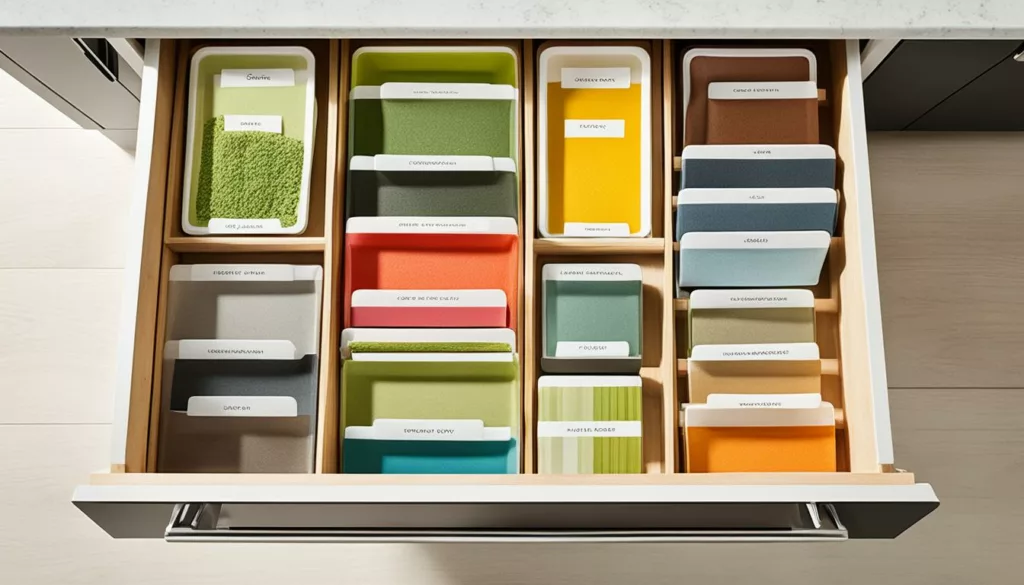
eco-friendly kitchen remodeling options
Kitchen remodeling can make your space both sustainable and energy-efficient. You can choose from sustainable materials to energy-efficient appliances to make your kitchen green. Let’s look at some top eco-friendly options for your kitchen.
Choosing sustainable materials for countertops, cabinets, and floors is key. Go for reclaimed wood, bamboo, or recycled glass to lessen environmental harm. Using water conservation tools like low-flow faucets also cuts down on water use.
Adding energy-efficient appliances is vital for a green kitchen. Pick Energy Star-rated models that use less energy and save money over time. Look into new appliance tech that focuses on saving energy and being sustainable.
Using old materials again is great for reducing waste and supporting a circular economy. Recycled components and repurposed furniture bring a unique touch to your kitchen and lessen your environmental impact.
For finishes and materials, choose non-toxic options without harmful chemicals. This keeps your indoor air clean for you and your family.
With these eco-friendly options, you can make your kitchen not just look good but also be sustainable, energy-efficient, and environmentally-friendly. Think carefully about your kitchen redo and help make a greener future.
Local Sourcing for Minimal Environmental Impact
Local sourcing is key for an eco-friendly kitchen remodel. It helps cut down on carbon emissions from long trips. Supporting local businesses and artisans makes the supply chain more sustainable.
Supporting Local Businesses and Artisans
Choosing local materials for your kitchen renovation is good for the planet and your community. Local businesses and artisans often use sustainable practices, reduce waste, and provide unique, high-quality items that can add character and charm to your new kitchen. This choice helps reduce your carbon footprint and supports your community’s growth.
- Discover local cabinetmakers, countertop fabricators, and tile artisans who use eco-friendly materials and sustainable manufacturing processes.
- Seek out local suppliers of reclaimed or repurposed wood, stone, and other building materials for a one-of-a-kind kitchen design.
- Connect with local artists and craftspeople who create custom backsplashes, lighting fixtures, or other kitchen accessories.
https://www.youtube.com/watch?v=l0Fvhv95ygo
“Embracing local sourcing not only reduces the environmental impact of your kitchen remodel but also celebrates the craftsmanship and creativity of your community.” – Jane Doe, Sustainable Design Consultant
By choosing local sourcing, you’re making your kitchen more eco-friendly. You’re also supporting the local economy and building community spirit. Look into the local resources in your area to inspire your kitchen renovation.
Minimalist Design for a Sustainable Kitchen
Choosing a minimalist design can make your kitchen remodel more sustainable. It focuses on simplicity, functionality, and a clean look. This way, you get a kitchen that looks good and is good for the planet.
Using repurposed furniture is a big part of a sustainable kitchen. Instead of buying new cabinets and countertops, think about using old pieces. For example, vintage dressers or salvaged wood can make your kitchen unique and eco-friendly.
Adding composting systems to your kitchen helps the environment too. It keeps food scraps and organic waste out of landfills. This supports sustainable waste management and feeds your garden or local composting programs.
“A minimalist kitchen is not just about aesthetics – it’s a way to live more sustainably and reduce your environmental footprint.”
With a minimalist design, repurposed furniture, and composting systems, your kitchen becomes a center of sustainability. It stays modern and looks great too.
Incorporating Repurposed Furniture and Decor
Give your kitchen a new look by using repurposed furniture and decor. These items can blend well with your kitchen’s look, adding charm and being good for the planet. Learn how to turn old items into beautiful, useful parts of your kitchen.
Giving New Life to Old Pieces
Think creatively about your kitchen’s look and feel. An old dresser can become a unique kitchen island with drawers and a work surface. Vintage chairs can be used as cozy seating, and a worn cabinet can hold your cookbooks and pottery.
- Repurpose old furniture into functional kitchen elements
- Incorporate vintage chairs and stools for seating
- Upcycle cabinets and dressers into storage and display units
Using repurposed furniture and decor makes your kitchen unique and green. It’s a way to give old items a new purpose and reduce waste. This approach keeps your kitchen looking simple yet stylish.
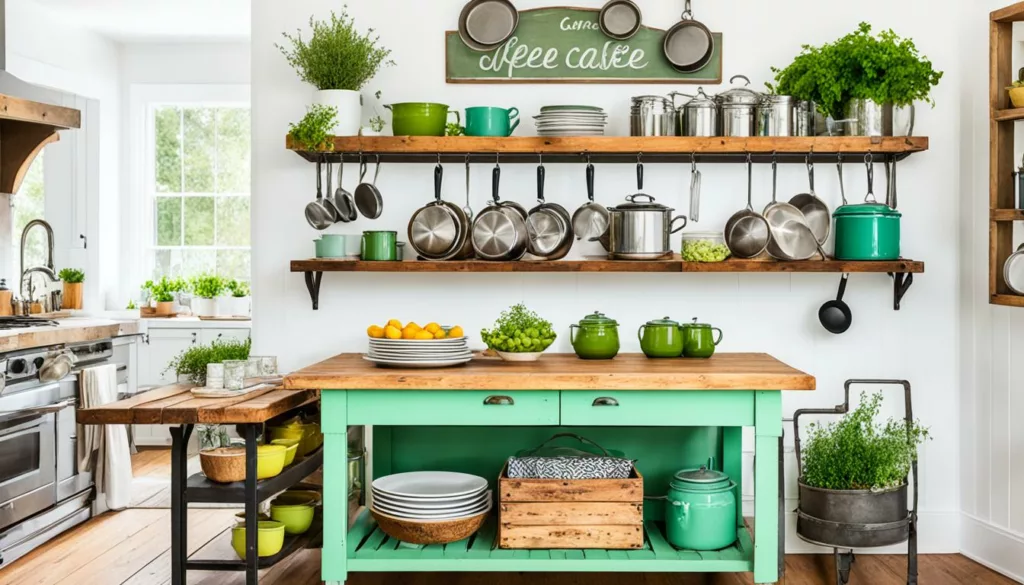
“Repurposing is not only eco-friendly, but it also allows you to inject your personality into your kitchen design.”
Turning old items into new kitchen pieces is rewarding and shows your creativity and care for the environment. Let your creativity run wild as you find new ways to use repurposed furniture and decor in your kitchen. This way, you’ll have a kitchen that looks great and is good for the planet.
Composting Systems for a Zero-Waste Kitchen
Starting a sustainable lifestyle begins in your kitchen. By using a composting system, you can help the planet and make your kitchen zero-waste. Composting turns food scraps into soil that’s full of nutrients. This helps create a cycle where waste is turned into something useful.
Composting systems are great for your eco-friendly kitchen. They cut down on waste and give you compost for your garden or plants. This way, you’re helping the planet and making your kitchen waste-free.
- Reduces food waste and landfill contributions
- Transforms food scraps into nutrient-rich compost
- Supports a circular, zero-waste system in your kitchen
- Enhances the health of your garden or indoor plants
“Composting is one of the simplest and most effective ways to reduce your kitchen’s environmental impact. It’s a game-changer in creating a sustainable, zero-waste lifestyle.” – sustainability expert, Jane Doe
Choosing a countertop or outdoor compost bin is up to you. Adding composting to your kitchen is a smart move towards a greener future. With composting systems and a zero-waste kitchen, you can make a big difference at home and beyond.
Conclusion
In this guide, you’ve learned many ways to make your kitchen eco-friendly. You can use sustainable materials, energy-efficient appliances, and water conservation strategies. Adding recycled components, non-toxic finishes, and local sourcing can also help.
Choosing a minimalist design and using furniture and decor again can make your kitchen look great and reduce waste. Adding composting systems takes your eco-friendly efforts even further, aiming for a zero-waste kitchen.
Every step towards eco-friendly living counts. Start using these eco-friendly kitchen remodeling options for a better future. Your kitchen can show how design and smart choices lead to a healthier, sustainable life.
FAQ
What are some eco-friendly materials I can use for my kitchen remodel?
Consider using bamboo, recycled glass, and natural stone for your kitchen. These materials are tough, good for the planet, and make your kitchen look great.
How can I make my kitchen more energy-efficient?
Switch to Energy Star-rated appliances like fridges, dishwashers, and ovens. They use less energy and cut down your bills. Look for appliances that save water and energy too.
What strategies can I use to conserve water in my kitchen?
Use low-flow faucets and fixtures to use less water. These modern options help you save water and live more sustainably.
How can I incorporate recycled and repurposed components into my kitchen remodel?
Get creative with old furniture, reclaimed wood, and recycled materials like glass or metal. It adds a unique touch and helps reduce waste.
Why is it important to use non-toxic finishes and paints in my kitchen?
Non-toxic paints and finishes keep the air in your kitchen clean. They’re good for the planet and make your kitchen healthier.
How can I support local businesses and artisans during my kitchen remodel?
Buying from local suppliers and craftspeople cuts down on transportation emissions and boosts your local economy. It makes your kitchen remodel more sustainable.
What are the benefits of a minimalist design approach for an eco-friendly kitchen?
Minimalist design reduces clutter and makes your kitchen more efficient. It lets you use repurposed furniture and composting systems easily. This style makes your kitchen look good and eco-friendly.
How can I incorporate composting systems into my kitchen remodel?
Adding a composting system helps you live zero-waste. It turns food scraps into nutrient-rich soil for your garden. This supports a sustainable lifestyle.

